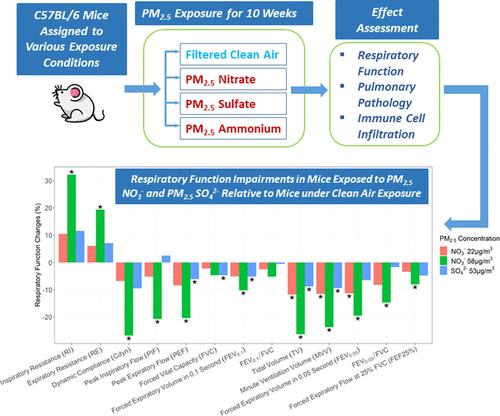当前位置:
X-MOL 学术
›
Environ. Sci. Technol.
›
论文详情
Our official English website, www.x-mol.net, welcomes your
feedback! (Note: you will need to create a separate account there.)
Chronic Exposure to PM2.5 Nitrate, Sulfate, and Ammonium Causes Respiratory System Impairments in Mice
Environmental Science & Technology ( IF 10.8 ) Pub Date : 2021-02-10 , DOI: 10.1021/acs.est.0c05814 Jushan Zhang 1, 2 , Haoxiang Cheng 3 , Dongbin Wang 4 , Yujie Zhu 1 , Chun Yang 1 , Yuan Shen 5 , Jing Yu 6 , Yuanyuan Li 7 , Shunqing Xu 7 , Shumin Zhang 8 , Xiaolian Song 1 , Yang Zhou 9 , Jia Chen 10 , Jingkun Jiang 4 , Lihong Fan 1 , Changhui Wang 1 , Ke Hao 1, 2, 3
Environmental Science & Technology ( IF 10.8 ) Pub Date : 2021-02-10 , DOI: 10.1021/acs.est.0c05814 Jushan Zhang 1, 2 , Haoxiang Cheng 3 , Dongbin Wang 4 , Yujie Zhu 1 , Chun Yang 1 , Yuan Shen 5 , Jing Yu 6 , Yuanyuan Li 7 , Shunqing Xu 7 , Shumin Zhang 8 , Xiaolian Song 1 , Yang Zhou 9 , Jia Chen 10 , Jingkun Jiang 4 , Lihong Fan 1 , Changhui Wang 1 , Ke Hao 1, 2, 3
Affiliation

|
Water-soluble inorganic (WSI) ions are major components of ambient air PM2.5 (particulate matter of diameter ≤2.5 μm); however, their potential health effects are understudied. On C57BL/6 mice, we quantified the effect of three major PM2.5 WSIs (NO3–, SO42–, and NH4+) on respiratory systems. Exposure scenarios include different WSI types, concentrations, animal development stages (young vs adult), and sex. The exposure effects were comprehensively assessed, with special focus on the respiratory function and tissue/cell level changes. Chronic PM2.5 NO3– exposure produced significant respiratory function decline, mainly presented as airflow obstruction. The decline was more profound in young mice than in adult mice. In young mice, exposure to 22 μg/m3 PM2.5 NO3– reduced FEV0.05 (forced expiratory volume in 0.05 s) by 11.3% (p = 9.6 × 10–3) and increased pulmonary neutrophil infiltration by 7.9% (p = 7.1 × 10–3). Causality tests identified that neutrophil infiltration was involved in the biological mechanism underlying PM2.5 NO3– toxicity. In contrast, the effects of PM2.5 SO42– were considerably weaker than NO3–. PM2.5 NO3– exposure was 3.4 times more potent than PM2.5 SO42– in causing reduction of the peak expiratory flow. PM2.5 NH4+ exposure had no statistically significant effects on the respiratory function. In summary, this study provided strong evidence on the adverse impacts of PM2.5 WSIs, where the impacts were most profound in young mice exposed to PM2.5 NO3–. If confirmed in humans, toxicity of PM2.5 WSI will have broad implications in environment health and policy making.
中文翻译:

长期暴露于PM 2.5硝酸盐,硫酸盐和铵盐会导致小鼠呼吸系统受损。
水溶性无机(WSI)离子是环境空气PM 2.5(直径≤2.5μm的颗粒物)的主要成分;但是,它们的潜在健康影响尚未得到充分研究。在C57BL / 6小鼠上,我们量化了三种主要的PM 2.5 WSI(NO 3 –,SO 4 2–和NH 4 +)对呼吸系统的影响。暴露情景包括不同的WSI类型,浓度,动物发育阶段(年轻与成年)和性别。对接触影响进行了全面评估,尤其侧重于呼吸功能和组织/细胞水平的变化。慢性PM 2.5 NO 3 –接触产生明显的呼吸功能下降,主要表现为气流阻塞。与成年小鼠相比,年轻小鼠的下降幅度更大。在年轻小鼠,暴露于22微克/米3 PM 2.5 NO 3 -还原FEV 0.05 11.3%(以0.05秒用力呼气量)(p = 9.6×10 -3),并通过7.9%增加肺中性粒细胞浸润(p = 7.1×10 –3)。因果关系检验确定了中性粒细胞浸润参与了生物机制底层PM 2.5 NO 3 -的毒性。相反,PM 2.5 SO的影响4 2 –比NO 3 –弱得多。PM 2.5 NO 3 –暴露是PM 2.5 SO 4 2 –的有效3.4倍,导致峰值呼气流量减少。PM 2.5 NH 4 +的暴露对呼吸功能没有统计学上的显着影响。总之,这项研究提供了有力的证据PM的不利影响2.5峰会,其中的影响是最深刻暴露于PM年轻小鼠2.5 NO 3 - 。如果在人体中证实,则PM 2.5的毒性 WSI将对环境健康和政策制定产生广泛影响。
更新日期:2021-03-02
中文翻译:

长期暴露于PM 2.5硝酸盐,硫酸盐和铵盐会导致小鼠呼吸系统受损。
水溶性无机(WSI)离子是环境空气PM 2.5(直径≤2.5μm的颗粒物)的主要成分;但是,它们的潜在健康影响尚未得到充分研究。在C57BL / 6小鼠上,我们量化了三种主要的PM 2.5 WSI(NO 3 –,SO 4 2–和NH 4 +)对呼吸系统的影响。暴露情景包括不同的WSI类型,浓度,动物发育阶段(年轻与成年)和性别。对接触影响进行了全面评估,尤其侧重于呼吸功能和组织/细胞水平的变化。慢性PM 2.5 NO 3 –接触产生明显的呼吸功能下降,主要表现为气流阻塞。与成年小鼠相比,年轻小鼠的下降幅度更大。在年轻小鼠,暴露于22微克/米3 PM 2.5 NO 3 -还原FEV 0.05 11.3%(以0.05秒用力呼气量)(p = 9.6×10 -3),并通过7.9%增加肺中性粒细胞浸润(p = 7.1×10 –3)。因果关系检验确定了中性粒细胞浸润参与了生物机制底层PM 2.5 NO 3 -的毒性。相反,PM 2.5 SO的影响4 2 –比NO 3 –弱得多。PM 2.5 NO 3 –暴露是PM 2.5 SO 4 2 –的有效3.4倍,导致峰值呼气流量减少。PM 2.5 NH 4 +的暴露对呼吸功能没有统计学上的显着影响。总之,这项研究提供了有力的证据PM的不利影响2.5峰会,其中的影响是最深刻暴露于PM年轻小鼠2.5 NO 3 - 。如果在人体中证实,则PM 2.5的毒性 WSI将对环境健康和政策制定产生广泛影响。











































 京公网安备 11010802027423号
京公网安备 11010802027423号